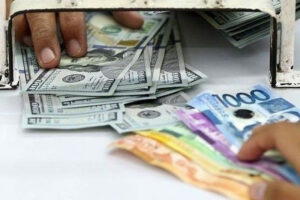




Policy Rate Updates: Double cut finale
 DOWNLOAD
DOWNLOAD

Monthly Economic Update: One for the road
 DOWNLOAD
DOWNLOAD

Inflation Update: Still low, still slow
 DOWNLOAD
DOWNLOAD


Peso strengthens to PHP 56 level for 1st time since April

The peso strengthened on Tuesday to the PHP 56-per-dollar level for the first time in four months, ahead of the central bank’s policy decision on Thursday.
The local unit closed at PHP 56.96 per dollar on Tuesday, up by 35.6 centavos from its PHP 57.316 finish on Monday, Bankers Association of the Philippines data showed.
This was the peso’s strongest finish since its PHP 56.808-per-dollar close on April 15.
Year to date, the peso has weakened by PHP 1.59 centavos from its PHP 55.37 finish on Dec. 29, 2023.
The peso opened Monday’s session at PHP 57.25 against the dollar. Its weakest showing was at PHP 57.985, while its intraday best was at PHP 56.92 versus the greenback.
Dollars exchanged jumped to USD 1.799 billion on Tuesday from USD 1.18 billion on Monday.
“The peso appreciated significantly below the PHP 57 level amid expectations of a softer US producer inflation report,” a trader said in an e-mail.
Another trader said the peso strengthened against the dollar amid position-taking ahead of the release of US inflation data on Wednesday.
“The Philippine peso and other Asian currencies appreciated against the US dollar, driven by a wave of risk-on sentiment. The (peso’s) rally is attributed to technical factors and market dynamics as investors anticipate key economic indicators: the US Producer Price Index (PPI) later (on Tuesday), the Consumer Price Index (on Wednesday), and the Philippine central bank’s policy decision on Thursday,” Security Bank Corp. Chief Economist Robert Dan J. Roces said in a Viber message.
The Monetary Board is set to hold its policy review on Thursday. A BusinessWorld poll conducted last week showed that nine of 16 analysts surveyed expect the Monetary Board to deliver a 25-basis-point (bp) rate cut that would bring the target reverse repurchase rate to 6.25%.
However, the second trader noted that the market expects the BSP to hold rates steady on Thursday.
BSP Governor Eli M. Remolona, Jr. told reporters on Tuesday there is still “room to stay tight” due to the strong second-quarter gross domestic product (GDP) data.
Philippine GDP expanded by an annual 6.3% in the April-to-June period, quicker than the revised 5.8% growth in the first quarter and 4.3% a year ago.
For the first semester, GDP growth averaged 6%, hitting the low end of the government’s target of 6%-7% this year.
Rizal Commercial Banking Corp. Chief Economist Michael L. Ricafort said in a Viber message the faster-than-expected inflation in July and strong second-quarter GDP growth reduced the likelihood of a rate cut this week.
Headline inflation accelerated to a nine-month high of 4.4% in July from 3.7% in June. It also marked the first time since November that inflation exceeded the central bank’s 2-4% annual target.
Meanwhile, Mr. Roces said the peso outlook for the rest of the year is still clouded as the BSP and the US Federal Reserve have not started easing.
For Wednesday, the first trader said the peso could continue strengthening ahead of US inflation data.
The first trader sees the peso moving between PHP 56.80 and PHP 57.05 a dollar, while the second trader expects it to range from PHP 56.80 to PHP 57.20. Mr. Ricafort sees the peso ranging from PHP 56.85 to PHP 57.05. – Aaron Michael C. Sy, Reporter
This article originally appeared on bworldonline.com





 By BusinessWorld
By BusinessWorld